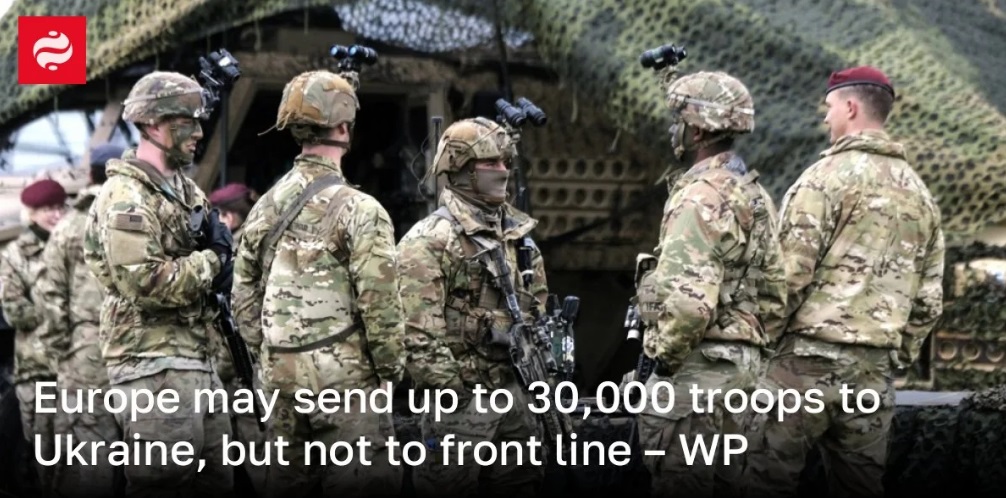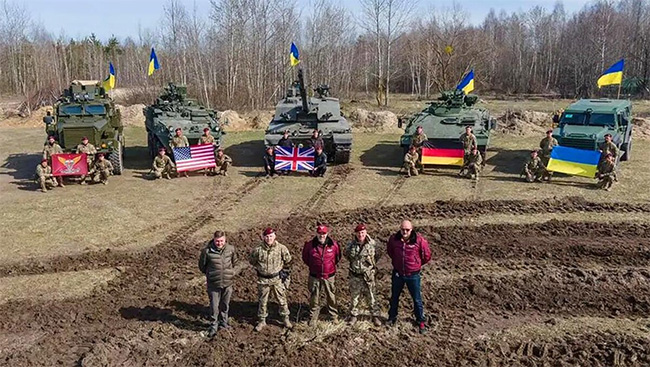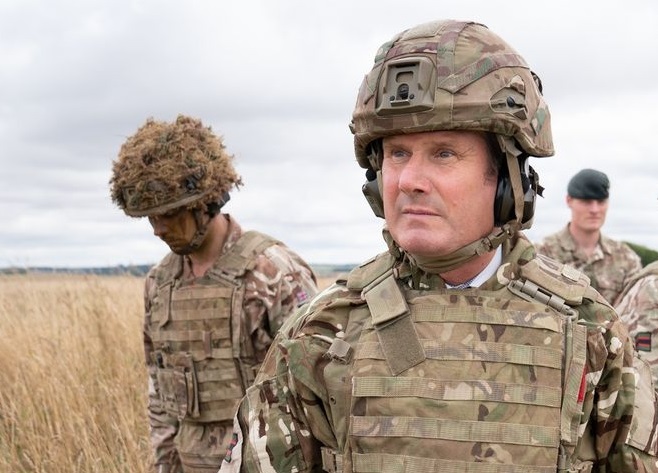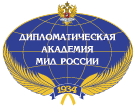
The prospect of deploying troops to Ukraine has gained traction among some European leaders in recent days as the Trump administration has moved quickly toward opening direct negotiations with Moscow. Ukraine’s European backers are scrambling for a role in the talks, which are advancing without them but could reshape the continent’s security landscape, ‘The Washington Post’ writes.
French President Emmanuel Macron convened a meeting of some of the continent’s top leaders in Paris on Monday to spur planning on European support for Ukraine and to forge a consensus on a potential deployment.
After Monday’s hours-long huddle, the British leader said that it was early to say how many troops and that there “must be a U.S. backstop.” Yet others, including Germany and Poland, showed hesitation to send their forces.
While Washington has ruled out U.S. troops in Ukraine, European officials say the Trump team has not excluded the prospect of supporting a European force and has asked what kind of U.S. backing might be necessary.
The European requests include intelligence, surveillance and reconnaissance capabilities, and potential air cover or some help with air defenses to protect the force, four officials briefed on the discussions said.
France has done more advanced military planning than others and estimates that it could commit nearly 10,000 troops, although other European allies remain more uneasy or have constrained militaries, two of the officials said.
Dutch Defense Minister Ruben Brekelmans told The Washington Post the plan would need more than just U.S. political backing. “You also want to have the escalation dominance,” he said, “if tensions would arise and if there would be any conflict… And we need to have the United States on board.”
For many European states, a deployment would also require public support at home and draw on already stretched military resources. France has more leeway than others, including Britain, in freeing up troops, partly because of a French drawdown in Africa.
Some countries, such as Poland or Germany, have national elections coming up and are wary of making big moves at a time when Russia’s war in Ukraine has become more politicized. Some have also been nervous about taking risks without greater U.S. involvement. And the Netherlands, for example, will need approval from parliament.
A Western diplomat described the talks with the Americans so far as “a chicken-and-egg game,” with each side waiting for the other to show their cards before declaring what resources they could commit.
 Western troops in Ukraine now.
Western troops in Ukraine now.
Photo: RIA Novosti
Increasingly alarmed that U.S. security priorities lie elsewhere, a group of European countries has been quietly working on a plan to send troops into Ukraine to help enforce any future peace settlement with Russia Associated Press notes.
Britain and France are at the forefront of the effort, though details remain scarce. The countries involved in the discussions are reluctant to tip their hand and give Russian President Vladimir Putin an edge should he agree to negotiate an end to the war he launched three years ago.
“I won’t get into the particular capabilities, but I do accept that if there is peace then there needs to be some sort of security guarantee for Ukraine and the U.K. will play its part in that,” British Prime Minister Keir Starmer said in cautious remarks.
The Europeans began exploring what kind of force might be needed about a year ago, but the sense of urgency has grown amid concern that U.S. President Donald Trump might go over their heads, and possibly even Ukraine’s, to clinch a deal with Putin.
In December, after Trump was elected but before he took office, a group of leaders and ministers huddled with Zelenskyy at NATO Secretary-General Mark Rutte’s residence in Brussels. They came from Britain, Denmark, France, Germany, Italy, the Netherlands and Poland. Top European Union officials attended too.
The talks built on an idea promoted by French President Emmanuel Macron in early 2024. At the time his refusal to rule out putting troops on the ground in Ukraine prompted an outcry, notably from the leaders of Germany and Poland.
Macron appeared isolated on the European stage, but his plan has gained traction since.
Still, much about what the force might look like and who will take part will depend on the terms of any peace settlement, and more.
“We are in a very early stage,” Hanno Pevklur, Estonia’s defense minister told The Associated Press on the sidelines of the Munich Security Conference.
While there are various ongoing discussions and rumors, it is “critical” for European allies to understand what the contact line in Ukraine will look like before coming up with a plan, Pevkur said.
But experts and officials warn that, as things stand, the Europeans must deploy a robust and sizeable contingent, rather than a team of peacekeepers like United Nations “blue helmets.”
“It has to be a real force (so) that the Russians know that if they ever tested it that they would get crushed. And you can be sure that Russia will test it,” Ben Hodges, the former Commanding General of U.S. Army Europe, said last month at a European Policy Centre think tank event.
Retired French Gen. Dominique Trinquand, a former head of France’s military mission at the United Nations, agreed that U.N. peacekeepers are better suited “for deployment in zones that are far more stable.”
“For starters, mounting this operation with soldiers taken from across the world would take about a year,” he said.
U.S. Defense Secretary Pete Hegseth insisted this week on “robust international oversight of the line of contact,” a reference to the roughly 1,000-kilometer (600-mile) long front line. The Europeans are reluctant as that would require too many troops.
“Any security guarantee must be backed by capable European and non-European troops,” Hegseth told almost 50 of Ukraine’s Western backers. If they go to Ukraine, he said, “they should be deployed as part of a non-NATO mission.”
Any European allies taking part would not benefit from NATO’s collective security guarantee if they were attacked, Hegseth said. He underlined that “there will not be U.S. troops deployed to Ukraine.” He did not reveal what role the U.S. might play.
 Keir Starmer, a British warrior.
Keir Starmer, a British warrior.
Photo: mirror.co.uk
Keir Starmer has said he is prepared to put British troops on the ground in Ukraine if there is a deal to end the war with Russia – acknowledging it could put UK forces “in harm’s way”.
Starmer said the crisis was a “once in a generation moment” and an “existential” question for Europe.
Writing in ‘The Daily Telegraph’, he said the UK was “ready to play a leading role” in Ukraine’s defence and security, including the commitment of £3bn a year until 2030. Starmer said that along with military aid, “it also means being ready and willing to contribute to security guarantees to Ukraine by putting our own troops on the ground if necessary”.
“I do not say that lightly. I feel very deeply the responsibility that comes with potentially putting British servicemen and women in harm’s way,” Starmer said.
“But any role in helping to guarantee Ukraine’s security is helping to guarantee the security of our continent, and the security of this country.
Military chiefs believe the UK cannot meet its existing military commitments – even before any involvement in any Ukraine peacekeeping force – within the existing defence budget of £64bn which amounts to 2.33% of GDP. But insiders have said Britain is willing to provide troops to a multinational peacekeeping force if that is what emerges from diplomatic efforts.
Any stepped-up UK military involvement would add to cost pressures, and the heads of the armed forces met Starmer individually on Friday to discuss the state of the military at a time when the army is struggling for numbers and is at its smallest size in over 200 years.
A defence source said the chiefs were not seeking to lobby the PM explicitly over defence spending but rather to “build up the PM’s knowledge of the armed forces”
Sir Keir Starmer’s proposal to put British troops on the ground as part of a peacekeeping force in Ukraine is a principled and politically bold move. But the sad reality is that Britain is in no position to act as Ukraine’s peacekeeper. Starmer is playing with an empty deck and singing from obsolete songbook, notes ‘The Spectator’.
Starmer’s offer to put British troops on the ground is, in practical military terms, a very small promise. As former British Army chief Lord Dannatt pointed out, the UK’s armed forces are ‘so run down’ that we could not lead any future peacekeeping mission in Ukraine. Estimated that a peacekeeping force of 200,000 foreign troops would be needed to police a 1,250 kilometre long line of contact. But the entire deployable force that Britain has is a mere 56,000 – compared to 1.1 million Ukrainians currently under arms.
Realistically, estimates Michael Kofman of the Carnegie Endowment for International Peace, the whole of Europe can come up with just three brigades, or less than 15,000 troops deployed at any one time. But the bigger question is ‘what should this force do, and how does it deter?’ asks Kofman. ‘If it is a tripwire, what does it attach to?… What is this force backed by, and what happens if it is attacked?’
So, without American backing, a European force would have limited credibility as a deterrent.
read more in our Telegram-channel https://t.me/The_International_Affairs

 10:26 20.02.2025 •
10:26 20.02.2025 •






















